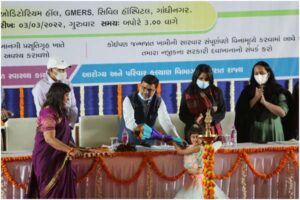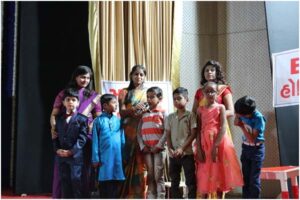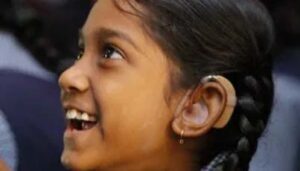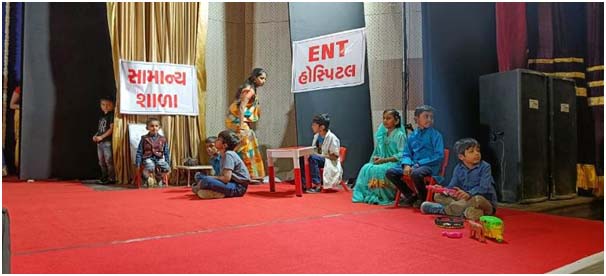- Government of Gujarat is offering free treatment up to Rs 8 lacs to hearing impaired kids
- About 1.6 crore children and teen are covered under the Rashtriya Bal Swasthya Karyakram (RBSK) (National Child Health Programme) in Gujarat
NE HEALTH BUREAU
GANDHINAGAR, MARC 5
“’The pipe is sweet,’ ‘the lute is sweet,’ by them’t will be averred,
Who music of their infants’ lisping lips have never heard.”
This was a couplet written about 2000 years ago by a Tamil Poet-Saint Thiruvalluvar and much loved our Prime Minister Narendra Modi.

According to this couplet, “The joy of hearing our children speak is incomparable with anything. That to the infant stages where they utter those baby words, even though they are imperfect and are more of babbles. Meanwhile, people who haven’t heard their children speak will appreciate the sound that comes out of musical instruments such as a pipe or a flute. Thiruvalluvar emphatically says that the only sound that brings immense joy to an individual is his/her child’s prattle and no other sound in this world can even stand comparable.”
This came true in the Gandhinagar GMERS Medical College and Hospital Auditorium, on Thursday, which was celebrated as World Hearing Day. The theme of World Hearing Day was “Hearing care for ALL! Screen. Rehabilitate. Communicate.”
Also, released a book of guidelines for Hearing and Screening for children and elderly along with the last two years screening report for newborn, school going and adults.
— Dr Mansukh Mandaviya (मोदी का परिवार) (@mansukhmandviya) March 3, 2022
Manoj Aggarwal – Additional Chief Secretary Health & Family, Shahmeena Husain – Health Commissioner, Dr Nayan P Jani -Additional Director (Family Welfare), Dr.Neelam Patel – Public Health, Dr.Dhaval Patel – Municipal Commissioner, Dr Nilesh Thakor, OSD – School Health Programme, and Dr. Kuldeep Arya – Gandhinagar Collector were present at the function.
To mark this day, over 80 cochlear implant recipient kids stole many hearts with their scintillating performances — singing, story-telling, and sharing their experiences — after undergoing these life-changing implants under the watchful eyes of their parents and the healthcare staff who made it possible with empathy and dedication.
Right from a three-year kid to teenage students performed well and got thunderous applause. They came from every nook and corner of the state with traditional and modern attire.
Gandhinagar Civil Cochlear Implant center has so far performed over 1,200 such surgeries on kids to make a difference in their lives. The Government of Gujarat is offering free treatment by spending up to Rs 8 lakh per hearing impaired kid. Super-Specialty treatment for Heart , Kidney and Cancer Disease including Renal Transplant, Liver transplant, Cochlear implant and Clubfoot also given free of cost. About 1.6 crore children and teen are covered under the Rashtriya Bal Swasthya Karyakram (RBSK) (National Child Health Programme) in Gujarat. 994 teams, 24 early detection centres and special mobile clinics have been deployed all over the state for its effective implementation, a senior most Health Dept official of the state government said.
This event was organized to raise more awareness about the theme under the School health programme – RBSK jointly with Gandhinagar Civil Cochlear implant center.
Dr. Neeraj Suri, ENT Specialist – Child Cochlear Implant Surgeon, Civil Hospital Gandhinagar, said, “The number of people living with unaddressed hearing loss and ear diseases needs timely intervention. Timely action is needed to prevent and address hearing loss across the life course. Hearing loss is the second most common handicap In India. The majority of it is treatable if done at the right time. Those children who are unable to hear from birth are not able to speak too. 2 out of every 1,000 children who are born have severe hearing loss, which requires advanced surgery called cochlear implantation.”
She also added good hearing and communication are important at all stages of life. Hearing loss (and related ear diseases) can be avoided through preventative actions such as protection against loud sounds; good ear care practices and immunization. Hearing loss (and related ear diseases) can be addressed when it is identified promptly and appropriate care sought.

1 in 4 people in the world will have some degree of hearing loss by 2050: WHO
The World Health Organization has warned that one in four people in the world – nearly 2.5 billion people – will be living with some degree of hearing impairment by 2050.
“By 2050 nearly 2.5 billion people will be living with some degree of hearing loss, at least 700 million of whom will require rehabilitation services. Failure to act will be costly in terms of the health and well-being of those affected, and the financial losses arising from their exclusion from communication, education, and employment,” the WHO said, in its first ”World Report on Hearing” released on Wednesday.
The report added that during the current times when the world is faced with the devastation caused by the COVID-19 pandemic, investing efforts and resources to prevent and address hearing loss is warranted for several reasons.

Catch them young
Cochlear implantation may be recommended if the hearing aid does not help. Experts say the sooner children with hearing loss receive cochlear implants, the better the results. A 2010 study published in the Journal of the American Medical Association found that children with profound hearing loss who received cochlear implants before 18 months of age were better able to hear, comprehend sound and music, and speak better than their counterparts who receive the implants at a later age. They also nearly caught up with their normal-hearing counterparts over the subsequent three years, said the study led by Johns Hopkins University that included the University of North Carolina at Chapel Hill. Research has shown that cochlear implant surgery is safe in children aged 7 to 12 months with appropriate aesthetic and postoperative support.
A cochlear implant is a small, but complex electronic device that can partially restores hearing in some people who are profoundly deaf or severely hard-of-hearing. Cochlear implant consists a microphone, a speech processor, a transmitter and receiver/stimulator, and an electrode array. The microphone picks up sound from the environment and the speech processor selects and arranges the sounds. Then the transmitter and receiver/stimulator convert the signals received from the speech processor into electric impulses. A group of electrodes collects these impulses and sends them to different regions of the auditory nerve. This way, the implant provides a representation of sounds in the environment to a deaf person and help him/her to understand speech. A cochlear implant has two main parts: one sits behind the ear and the other is surgically placed under the skin.
A cochlear implant won’t cure deafness or hearing impairment, but it stimulates the cochlea, a portion of the inner ear that receives sound (vibrations), and converts them into nerve impulses which are then sent to the brain to be interpreted. The quality of sound processed by this prosthetic substitute is comparatively low and therefore it doesn’t help restore hearing to normal levels.









